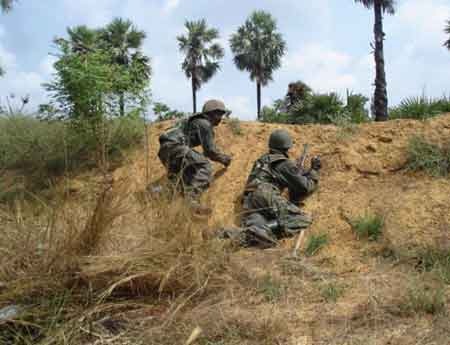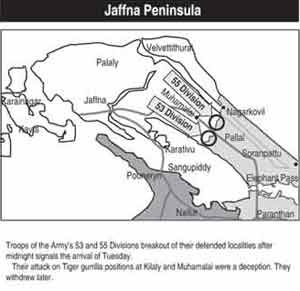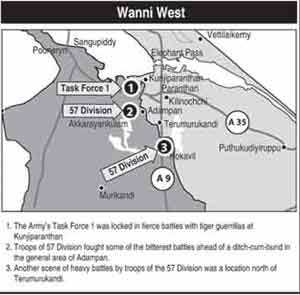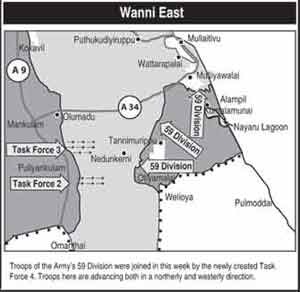- Heavy casualties as 7,000 troops launch major offensive and LTTE counter attacks
- Army in new recruitment drive to form Task Force 5; but war to continue in 2009
By Iqbal Athas
Last Tuesday, some 7000 troops fought the Tiger guerrillas in what was their fiercest battle ever in the ongoing Eelam War IV.
Their major thrust, with enormous firepower, was directed at regaining control of Kilinochchi, until months ago the political power centre of the Liberation Tigers of Tamil Eelam (LTTE).
Troops fought pitched battles in five different fronts. The guerrillas, who have now begun to throw their hardcore cadres into battle, offered stiff resistance to prevent the fall of Kilinochchi. In at least two fronts, troops were able to secure little more ground whilst in others they were forced to return to original positions from which they began their advance.

The fact that adversaries give exaggerated counts of their rival’s casualties during wars is too well known. It is no different in Sri Lanka. The point has been made quite clearly in the past few weeks by international news agencies and global television networks. They said that both official and guerrilla casualty counts are regularly exaggerated by each other. Independent verification is not possible since the media are not allowed into the battle areas, they would repeat when giving accounts about the ongoing separatist war in Sri Lanka.
 Unlike in the past, for reasons that are too obvious now, counts that are credible, obtained from unimpeachable military sources, cannot be revealed either. Otherwise, the public who fund the war effort would have been able to discern better the course of events, the achievements made by the troops and the sacrifices they make. It would also give the world outside a better understanding about the ruthless enemy the troops have to face.
Unlike in the past, for reasons that are too obvious now, counts that are credible, obtained from unimpeachable military sources, cannot be revealed either. Otherwise, the public who fund the war effort would have been able to discern better the course of events, the achievements made by the troops and the sacrifices they make. It would also give the world outside a better understanding about the ruthless enemy the troops have to face.
In the past weeks, talk was agog at the highest levels of the defence and security establishment of a concerted major military thrust to re-capture Kilinochchi. The matter has been the subject of intense attention in not only Sri Lanka but also the world over. With news that Kilinochchi would fall anytime now, I had occasion to meet and chat with foreign journalists who had come to cover the event which was expected to materialise within days. Most have left.
 It began just after midnight that signalled the dawn of Tuesday. Troops of the Army’s 53 and 55 Divisions broke out of their defended localities at Muhamalai. The frontage here runs across the thin isthmus that links the Jaffna peninsula to mainland Sri Lanka. The 53 Division advanced towards guerrilla positions on the western side at Kilali. Troops of the 55 Division, who now occupy what was once the first line of guerrilla defences, advanced from locations east of the now defunct entry- exit point at Muhamalai.
It began just after midnight that signalled the dawn of Tuesday. Troops of the Army’s 53 and 55 Divisions broke out of their defended localities at Muhamalai. The frontage here runs across the thin isthmus that links the Jaffna peninsula to mainland Sri Lanka. The 53 Division advanced towards guerrilla positions on the western side at Kilali. Troops of the 55 Division, who now occupy what was once the first line of guerrilla defences, advanced from locations east of the now defunct entry- exit point at Muhamalai.
The two Divisions engaged guerrilla positions ahead of them in bitter gun battles. It was only last week a senior Army officer told The Sunday Times (Situation Report), "Since the re-capture of the first line of guerrilla defences at Muhamalai, they (the guerrillas) have inducted more hardcore cadres to the second line. They have also strengthened Pallai (south of Muhamalai) and Kilaly areas."

As the fighting continued, the guerrillas offered stiff resistance. However, they were then unaware that troops here were only engaged in a deception and were not the main elements in a fierce thrust towards Kilinochchi. After a short while, they had withdrawn to their original positions. Such a fierce thrust came only at 6 a.m. on Tuesday simultaneously from three other different fronts. This was six hours after the 53 and 55 Divisions had staged a deception by feigning to fight their way through to Kilinochchi. See map of Jaffna peninsula.
(For updates you can share with your friends, follow TNN on Facebook and Twitter )
